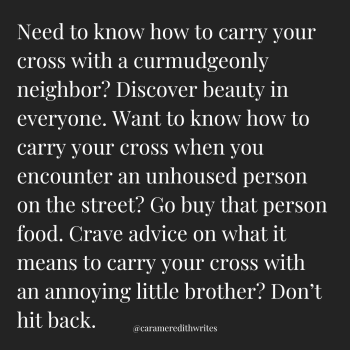Bringing you some oldies but goodies …homilies that were written and delivered, but never actually made it onto the ol’ Patheos blog. This one was from July of 2021; as per the usual, if you want to catch the video, check out St. Paul San Rafael’s Facebook page!

In today’s passages, we have a request for a human head on a serving platter, as well as a directive for a very important Old Testament prophet to leave and get the heck out of dodge.
It’s always, in times like these, when my first reaction is to squeeze my eyes shut and shake my head from side-to-side and utter what?!, that I find myself wondering how such stories make their way into the Bible in the first place.
Where is God in the midst of such obvious wickedness? Why are passages like these purposefully paired alongside the loveliest of psalms and an epistle found chock full of nouns like faithfulness and righteousness, and blessings and mystery and grace? Because where is righteousness when Herod’s wife gives that directive? Where is grace when a so-called prophet of doom is told to flee from the land, from his land?
But as I sat with these passages this week, I couldn’t help but see how questions and answers of identity also flow from the page.
In the Old Testament passage, when the high priest, Amaziah, finds himself unhappy with Amos’ words, he tells him to FLEE and never again prophesy at Bethel. If we were to look back at earlier chapters, we would learn even more about the unpopularity of Amos’ words, including his very unpopular opinion about economic injustice – the “structural and systemic injustice that perpetuate social inequality” – for Amos is somewhat of an extremist for justice. Amos is the one Dr. King perpetually quoted, the one who prophesied, “Let justice roll down like waters and righteousness like an ever-flowing stream.”
So, when Amaziah tells him to flee, Amos tells him the truth of who he is. He’s an outsider, not an insider. And to Amaziah’s words, he says:
“I am no prophet, nor a prophet’s son; but I am a herdsman, and a dresser of sycamore trees, and the Lord took me from following the flock, and the Lord said to me, ‘Go, prophesy to my people Israel.’”
Amos takes Amaziah’s rebuke and instead says, THIS is who I am. And THIS is who I am not. And, by the way, this is how God finds me, meets me, directs me, and loves me along the way.
In all actuality, I don’t think Amos’ reply is all too far from our own.
Whether we’re 13 or 32, 8 or 85, we humans are constantly searching for meaning …and part of finding that meaning means discovering who we are (and who we’re not) along the way, including who we are as beloved children of God.
Who am I? Who am I not? And how is God finding me, meeting me and loving me along this journey?
Two quick thoughts:
A couple decades ago, one of my best friends from college declared aloud her love for middle school students. At the time, I was a high school English teacher, so I had my own feelings about the coolest adolescent age group (middle school students, if you’re listening, I’ve since changed my mind and now think any human under the age of 104 is the coolest, yourself most definitely included).
At the time, Anna was a middle school youth pastor. Later, she would become a middle school guidance counselor, and then a therapist who specializes in children and adolescents. Always, right after she declared those gangly, awkward, egocentric, always running from point A to point B, just because, loveable middle school students Best People On the Planet, she’d say, “They’re the best because all of them are looking for answers to the same three questions: Who am I? Who are my friends? Where am I going?”
I couldn’t help but think about those same three questions when Amaziah told Amos to get out of town, and Amos responded with “who” and “where” answers of his own. Well, again, let me tell you, Amaziah: this is who I am. And this is who I am not. And also? This is who God is to me too.
In a sense, we’re all just asking and answering the same three questions.
Around the same time that Anna declared her love for the 11 to 14-year-old population, I discovered a writer named Anne Lamott. (Lamott, of course, is a staple here in Marin: she’s home grown. She’s one of our own. We wonder, or perhaps, I wonder, if it’s too much to pay a visit St. Andrew in Marin City on a random Sunday morning, just to see if she happens to be teaching Sunday School, just to see if the huge flea market across the street that initially drew her in is still there).
For Lamott, who isn’t an academic theologian we Episcopalians are sometimes prone to quote in our sermons, but instead, a regular old writer who writes about the real things, the funny things, and the holy-twinged God things of life, often answers questions of identity too.
And in one of her newest books, Dusk Night Dawn, she tells the story of a pastor friend’s grandfather. When this woman was young, “a friend asked her what he did. She replied, ‘Every Sunday he stands in front of everyone and tells them that they are beautiful, and God loves them exactly the way they are, and they really don’t have to worry, because they all have each other. But then by Tuesday they forget this, so on Sunday he goes back to their church and tells them that they are beautiful, and God loves them just the way they are, and they don’t have to worry because they all have one another.”
It’s the only three-part message we need to hear too, the one that should always be on repeat.
For you, child of God, are beautiful.
You, my friend, are loved exactly as you are, no exceptions to the rule.
And you, my dear ones, need not worry one iota, because of this right here – you have, we have, we’ve got each other, St. Paul’s.
And this each other changes us, if we let it. If we let ourselves be held and hold each other; if we dare trust each other with both the messy and the beautiful things, with the pain and the joy and everything in-between.
Because as Eugene Petersen says of Ephesians 1 in The Message translation, “Long before God laid down earth’s foundations, God had us in mind, had settled on us as the focus of God’s love, to be made whole and holy by God’s love. Long, long ago Goddecided to adopt us into the family through Jesus Christ. (What pleasure God took in planning this!) God wanted us to enter into the celebration of this lavish gift-giving by the hand of God’s beloved Son.”
Could this us really be us? Our beautiful, messy, loved-by-God, St. Paul’s San Rafael selves? I think it can. And I think it is.
For just as we see in Amos, God continues to set things right, because God will never again pass us by: both of these truths are part of what we see in today’s passages, just as we rest in that one, most important question and answer.
Who are you? You are beautiful. You are loved. And you need not worry, because friends, you have one another.
Amen.
—
What message of identity are you leaning into this week?













